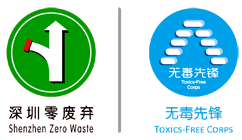2017年12月以来,我国已制定发布了两批《优先控制化学品名录》。根据要求,对列入名录的化学品,应当针对其产生环境与健康风险的主要环节,依据相关政策法规,结合经济技术可行性,采取风险管控措施,最大限度降低化学品的生产、使用对人类健康和环境造成的重大影响。
生活垃圾焚烧是优先控制化学品的重要排放源,其特征污染物中名列《优控名录》的就有10余种。
根据生活垃圾焚烧发电厂自动监测数据公开平台的信息,截至2021年10月31日,我国在运营焚烧厂共有642座,垃圾焚烧能力达73.4万吨/天。近两年,全国各省(市)如火如荼地开展了直至2030年的焚烧中长期规划。按照规划的布局,焚烧厂的数量和处理量还将继续增长。
可见,优控化学品管控是生活垃圾焚烧生态环境风险防控的重要组成部分,且未来一定时期内都将如此。
然而现阶段,我国生活垃圾焚烧行业优先控制化学品的管控法规尚存在污染物指标缺失、标准不够严格、监测频次低等诸多不足。焚烧行业实际运营中,存在烟气排放和周边环境质量的自行监测和监督性监测信息公开状况较差,飞灰检测信息公开率非常低等问题。
根据信息公开获得的信息,虽然我国焚烧行业的烟气二噁英和重金属的监测浓度能达到国标的要求,然而与欧盟BAT/BEP(最佳可行技术/最佳环境实践)的标准相比依然有差距。而且,多项研究已经表明,在生活垃圾焚烧厂附近,以重金属、持久性有机污染物为主的优先控制化学品在环境介质中可被广泛检出,周边人群具有较高的潜在环境暴露风险。
为了减少垃圾焚烧行业优先控制化学品的排放,本报告提出了10条BAT/BEP建议。技术上的建议主要包括提高运营稳定性和烟气净化技术减少污染物的产生和排放,运用连续采样监测烟气二噁英和在线监测技术监测烟气重金属来更好地判断焚烧厂的运行状况,妥善处置飞灰从而降低其生态风险。除此之外,制定禁烧目录、保障公众参与与全面信息公开也能促进焚烧厂达标运行。
当然最根本的,解决垃圾问题要由“末端处置思维”转变到“综合管理思维”,参照联合国环境署的垃圾管理优先次序原则,制定“零废弃”战略。只有从前端控制了垃圾的产生以及促使各类垃圾各得其所,垃圾焚烧的优先控制化学品环境风险才能从根本上得以管控。
Abstract
Since December 2017, China has formulated and released two batches of the Priority Control Chemicals List. According to the requirements, chemicals listed in the list should be targeted at the main links that generate environmental and health risks, and risk control measures should be taken in accordance with relevant policies and regulations, combined with economic and technical feasibility, to minimize the significant impact of the production and use of chemicals on human health and the environment.
The incineration of domestic waste is an important source of emissions for priority control chemicals, and there are more than 10 kinds of characteristic pollutants listed in the "Priority Control Chemicals List".
According to the information of the public platform of automatic monitoring data of domestic waste incineration power plants, as of October 31, 2021, there were 642 incineration plant enterprises in China, with a waste incineration capacity of 734 thousand tons per day. In the past two years, many provinces (municipalities) made the medium and long-term plan of incineration until 2030. According to the layout of the plan, the number of incineration plants and treatment capacity will continue to grow.
It can be seen that the control of priority control chemicals is an important part of the ecological and environmental risk prevention and control of domestic waste incineration, and will be so for a certain period of time in the future.
However, at this stage, the control regulations of priority control chemicals in domestic waste incineration industry in China still have many shortcomings, such as the lack of pollutant indicators, not strict enough standards, and low monitoring frequency. In the practical operation of the incineration industry, there are problems such as the poor state of disclosure of information on self-monitoring and supervisory monitoring of flue gas emissions and ambient environmental quality, and the very low rate of disclosure of information on fly ash testing.
According to the information obtained from information disclosure requests, although the monitoring concentrations of flue gas dioxins and heavy metals in China's incineration industry can meet the requirements of national standards, however, there is still a gap compared to the EU BAT/BEP (Best Available Techniques/Best Environmental Practices) standards.
Moreover, several studies have shown that priority control chemicals, such as heavy metals and persistent organic pollutants, can be widely detected in the environmental media near domestic waste incineration plants, and the surrounding population has a high potential risk of environmental exposure.
In order to reduce emissions of priority control chemicals from the waste incineration industry, this report proposes 10 BAT/BEP recommendations. Technical recommendations include improving operational stability and flue gas cleaning technologies to reduce pollutant generation and emissions, using continuous sampling to monitor flue gas dioxins and online monitoring technologies to monitor heavy metals in flue gas to better determine the operational status of incineration plants, and disposing of fly ash properly so as to reduce its ecological risks. In the meantime, the development of a list of waste banned from incineration, public participation and full information disclosure can also promote the compliance of incineration plants. Most fundamentally, of course, the solution to the waste problem must shift from an "end-of-pipe disposal mindset" to an "integrated management mindset," i.e. develop a "zero-waste" strategy with reference to the UNEP's waste hierarchy. Only by controlling the generation of waste from the front end and promoting the proper dealing of all types of waste can the environmental risks of waste incineration be controlled fundamentally.


